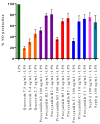Immunomodulating activity of Aronia melanocarpa polyphenols
- PMID: 24983479
- PMCID: PMC4139804
- DOI: 10.3390/ijms150711626
Immunomodulating activity of Aronia melanocarpa polyphenols
Abstract
The immunomodulating effects of isolated proanthocyanidin-rich fractions, procyanidins C1, B5 and B2 and anthocyanins of Aronia melanocarpa were investigated. In this work, the complement-modulating activities, the inhibitory activities on nitric oxide (NO) production in LPS-induced RAW 264.7 macrophages and effects on cell viability of these polyphenols were studied. Several of the proanthocyanidin-rich fractions, the procyanidins C1, B5 and B2 and the cyanidin aglycone possessed strong complement-fixing activities. Cyanidin 3-glucoside possessed stronger activity than the other anthocyanins. Procyanidins C1, B5 and B2 and proanthocyanidin-rich fractions having an average degree of polymerization (PD) of 7 and 34 showed inhibitory activities on NO production in LPS-stimulated RAW 264.7 mouse macrophages. All, except for the fraction containing proanthocyanidins with PD 34, showed inhibitory effects without affecting cell viability. This study suggests that polyphenolic compounds of A. melanocarpa may have beneficial effects as immunomodulators and anti-inflammatory agents.
Figures



Similar articles
-
Extracts, anthocyanins and procyanidins from Aronia melanocarpa as radical scavengers and enzyme inhibitors.Nutrients. 2013 Mar 4;5(3):663-78. doi: 10.3390/nu5030663. Nutrients. 2013. PMID: 23459328 Free PMC article.
-
In vitro inhibition of cytochrome P450 3A4 by Aronia melanocarpa constituents.Planta Med. 2013 Jan;79(2):137-41. doi: 10.1055/s-0032-1328055. Epub 2012 Dec 18. Planta Med. 2013. PMID: 23250807
-
Black chokeberry (Aronia melanocarpa) polyphenols reveal different antioxidant, antimicrobial and neutrophil-modulating activities.Food Chem. 2019 Jun 30;284:108-117. doi: 10.1016/j.foodchem.2019.01.108. Epub 2019 Jan 23. Food Chem. 2019. PMID: 30744834
-
Aronia plants: a review of traditional use, biological activities, and perspectives for modern medicine.J Med Food. 2010 Apr;13(2):255-69. doi: 10.1089/jmf.2009.0062. J Med Food. 2010. PMID: 20170359 Review.
-
Current knowledge of Aronia melanocarpa as a medicinal plant.Folia Med (Plovdiv). 2006;48(2):11-7. Folia Med (Plovdiv). 2006. PMID: 17408071 Review.
Cited by
-
Effects of antioxidant supplementation on oxidative stress balance in young footballers- a randomized double-blind trial.J Int Soc Sports Nutr. 2021 Jun 7;18(1):44. doi: 10.1186/s12970-021-00447-z. J Int Soc Sports Nutr. 2021. PMID: 34098993 Free PMC article. Clinical Trial.
-
Effect of UV-C Radiation, Ultra-Sonication Electromagnetic Field and Microwaves on Changes in Polyphenolic Compounds in Chokeberry (Aronia melanocarpa).Molecules. 2017 Jul 12;22(7):1161. doi: 10.3390/molecules22071161. Molecules. 2017. PMID: 28704941 Free PMC article.
-
Topical Application of Aronia melanocarpa Extract Rich in Chlorogenic Acid and Rutin Reduces UVB-Induced Skin Damage via Attenuating Collagen Disruption in Mice.Molecules. 2020 Oct 7;25(19):4577. doi: 10.3390/molecules25194577. Molecules. 2020. PMID: 33036412 Free PMC article.
-
Potential Benefits of Black Chokeberry (Aronia melanocarpa) Fruits and Their Constituents in Improving Human Health.Molecules. 2022 Nov 13;27(22):7823. doi: 10.3390/molecules27227823. Molecules. 2022. PMID: 36431924 Free PMC article. Review.
-
Medicinal Plants and Isolated Molecules Demonstrating Immunomodulation Activity as Potential Alternative Therapies for Viral Diseases Including COVID-19.Front Immunol. 2021 May 13;12:637553. doi: 10.3389/fimmu.2021.637553. eCollection 2021. Front Immunol. 2021. PMID: 34054806 Free PMC article. Review.
References
Publication types
MeSH terms
Substances
LinkOut - more resources
Full Text Sources
Other Literature Sources

